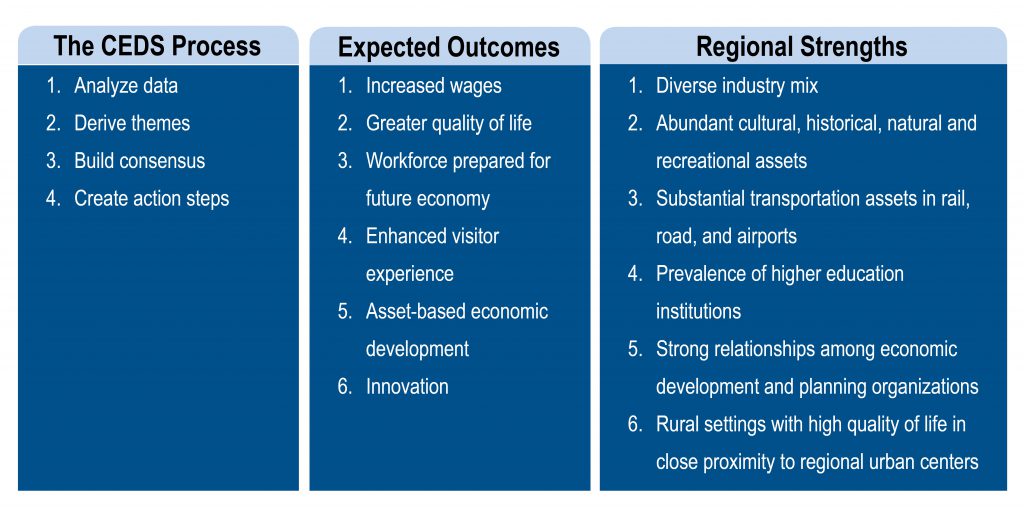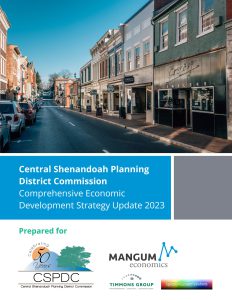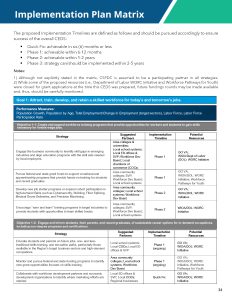Comprehensive Economic Development Strategy
The Central Shenandoah Planning District Commission is a designated Economic Development District (EDD) under a program administered by the U.S. Department of Commerce’s Economic Development Administration (EDA). One of the CSPDC’s primary responsibilities as an Economic Development District is to prepare a Comprehensive Economic Development Strategy (CEDS) for the District. A key component of the CEDS is to establish and maintain a robust, diverse economic ecosystem. The CEDS provides a platform for individuals, organizations, local governments, institutes of learning, and private industry to engage in a meaningful conversation about how local strengths can be leveraged to improve overall quality of life and how barriers can be overcome to achieve goals. Establishing regional economic development goals through an intensive planning process is not only important in terms of setting roles and responsibilities among stakeholders, completing an EDA-approved CEDS unlocks federal and state funding sources that are invaluable to localities who may not otherwise have access to capital.
The Central Shenandoah Region is an area rich in employment opportunities, natural resources, and economic assets that can support sustainable growth into the future. Every corner of the Central Shenandoah Region is diverse in its geography and industry mix, which is part of what makes the region enticing to residents and businesses alike.
Focused on sustaining and enhancing these characteristics, the CSPDC engaged in a CEDS to pursue strategy-driven regional economic development. The CEDS serves as a roadmap to guide the region in achieving their vision.
Moving Forward Together
The CSPDC'S CEDS contains five ambitious goals, which are outlined in the following dropdowns. Beneath each vision are goals, which help define how that vision will be achieved. Nearly every goal requires collaboration from not only localities, but regional economic development and planning partners.
GOAL 1: Attract, train, develop, and retain a skilled workforce for today’s and tomorrow’s jobs.
OBJECTIVE 1
Create and expand workforce training programs that provide opportunities for workers and students to gain skills necessary for livable wage jobs.
OBJECTIVE 2
Engage and inform students, their parents, and recent graduates, of sustainable career options for in-demand occupations, including non-degree programs and certifications.
OBJECTIVE 3
Expand the workforce talent pool in the Central Shenandoah Region by attracting new residents and retaining workers.
OBJECTIVE 4
Improve and expand wrap-around services to allow for increased worker participation.
GOAL 2: Support existing businesses while also attracting and developing new businesses that will diversify our economy and generate job growth.
OBJECTIVE 1
Ensure key transportation corridors throughout the Central Shenandoah Region, especially I-81, allow for safe and timely transit of raw materials, finished goods, and area workers and residents.
OBJECTIVE 2
Ensure suitable commercial and industrial sites are available to and ready for business and industry.
OBJECTIVE 3
Pursue expansion of broadband, cellular services, and other critical infrastructure to underserved areas of the Region.
OBJECTIVE 4
Ensure a comprehensive entrepreneurial ecosystem is available equitably, consistently, and effectively throughout the Central Shenandoah Region.
OBJECTIVE 5
Support and promote the Region’s agribusiness sector by expanding markets for farmers, producers, food manufacturers, and related sectors.
GOAL 3: Address immediate and long-term housing needs to ensure that all residents and workers have an affordable place to live.
OBJECTIVE 1
Improve the availability, quality, and diversity of the Region’s housing stock.
OBJECTIVE 2
Ensure housing is affordable relative to wages in the Central Shenandoah Region and workers are not priced out of the region.
OBJECTIVE 3
Convene local government leaders, non-profit organizations, State agencies, residential developers, and area employers to identify obstacles and solutions for expanding affordable housing options across the Region.
GOAL 4: Implement placemaking strategies and community building efforts that enliven downtown areas, provide cultural enrichment, and promote social interaction and economic growth.
OBJECTIVE 1
Create vibrant downtowns and activity centers that attract a diverse range of businesses, residents, and visitors.
OBJECTIVE 2
Leverage the Region’s unique natural, cultural, and historic assets to promote outdoor recreation, improve quality of life, and enhance the local, state, national, and global draw for visitors.
OBJECTIVE 3
Create a unique sense of place that attracts businesses, residents, and tourists.
GOAL 5: Expand the Region’s capacity to prevent, withstand, and quickly recover from major economic disruptions.
OBJECTIVE 1
Promote the importance of defining land use plans that enable each locality to attract a diverse mix of sustainable business, industry, residential, and recreational uses.
OBJECTIVE 2
Develop and update planning, education, and mitigation activities on a recurrent basis, incorporating relevant studies and resources as appropriate.
Action Plan
The planning process was initiated with the understanding that developing relationships among stakeholders in the public and private sector would be essential for successful implementation. The factors, partners and other resources expected for implementation are detailed in the Implementation Plan Matrix. Potential funding sources are identified so that the organization can launch into implementation from planning. CSPDC anticipates taking on the role of facilitator, while enabling local experts to take on goal areas that match their expertise. Additionally, each objective has a performance measure, which will be updated along with other necessary elements during each annual review of the CEDS required by the Economic Development Administration.
For more information please contact the CSPDC offices.



